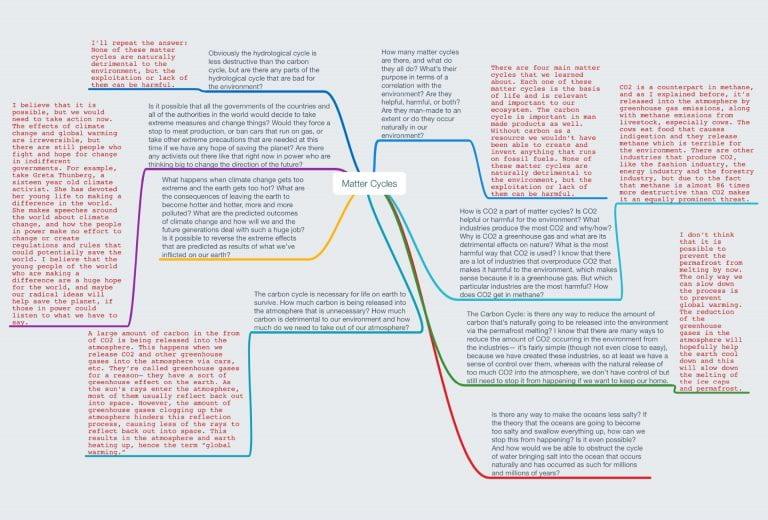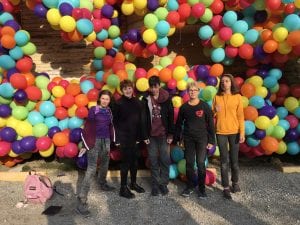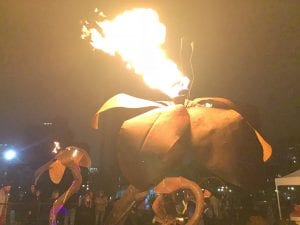Hey there. Welcome back to my blog! It’s time for another fun, exciting post about… science! We recently finished a unit on the biogeochemical cycles. And when a unit is finished, you know what that means…… a blog post! So here we are.
We began this unit, well, learning about the matter cycles, specifically the Carbon Cycle, the Hydrological Cycle, the Nitrogen Cycle and the Phosphorus Cycle. But even before we began learning about these matter cycles, we got a general idea of what this unit was going to cover with some crash course videos and Khan Academy quizzes about ecology, trophic levels, the cycles, and our impact on the cycles. This was a good precursor for learning about the cycles themselves, especially the human impact, because the project I ended up producing was largely based off of the impact that humans have on the cycles, specifically the carbon cycle, but I’ll get into that in a little bit.
Back to the beginning again, after the matter cycles quizzes and education on the ecosystems and trophic levels, we had a debate to decide which matter cycle was the best. I was debating in favour of the carbon cycle against the hydrological cycle. I am sorry to say we didn’t win, but I learned a fair bit about the opposing cycle by having the opportunity to try and prove why the carbon cycle was better! It was also pretty entertaining to see the other teams debate.
After this, we began on our actual project. The driving question for this unit was, “How do living things rely on and affect matter cycles?”. The task was to design a machine or system that could help reduce or reverse any negative impacts or effects on/of your matter cycle. I was in a group with Jason and we came up with a pretty cool idea!
Since we had the matter cycle, it was pretty evident that we should design something to do with climate change and reducing some of the many detrimental effects of it. We decided to focus on methane, and specifically the cows that release methane into our atmosphere. As I explained in my Mind Map above, methane is 86 times more destructive than plain CO2. The agriculture industries is one of the most harmful to the environment due to its production of methane. We came up with a machine that could help reuse this excess of methane produced by the cows and use it in fuel.
I won’t explain exactly how the process works, but simply, the methane is captured and compressed into a liquid, where it is then converted to methanol which can be blended with regular gasoline to create a more eco-friendly fuel with lower emissions than regular gasoline.
Here is some more specifics of our project. These are from our Keynote:
Now that we’ve gotten our feedback, I can narrow down what curricular competencies we did well with, and why:
Applying and innovating
- Contribute to care for self, others, community, and world through individual or collaborative approaches
Our machine is meant to help reduce the emissions of methane into the environment, while creating a clean source of fuel to power our vehicles. This solution contributes to the care of the planet, along with its inhabitants.
- Contribute to finding solutions to problems at a local and/or global level through inquiry
We tried to consider the most important and relevant issues with the carbon cycle. Methane happens to be such a pressing issue locally and globally, so finding a solution/creating an innovative machine that attempts to solve such a large-scale problem meets this criteria quite well.
- Consider the role of scientists in innovation
We ourselves had to be scientists to make this machine. For example, we had to figure out how to separate methane from other gases when filtering it into a cryotank to be frozen. (You must put it through a special membrane to filter out the excess gases.) We also had to figure out how to convert the methane into methanol, which is a scientific process. This entire project is based off of scientifically proven issues and ideals.
Communicating
- Communicate scientific ideas, claims, information, and perhaps a suggested course of action, for a specific purpose and audience, constructing evidence-based arguments and using appropriate scientific language, conventions, and representations
Our project is based on climate change, which has been scientifically proven to be happening. It is an obvious threat and not to be taken lightly. We have created a machine that can help reduce the effects of climate change, which is our suggested course of action to solve this problem. We used evidence to support how our machine can help reduce methane emissions and contribute to slowing down the process of global warming.
In conclusion, we can connect back to the driving question, “How do living things rely on and affect matter cycles?”. This project focuses on how the cows we use for meat production have an impact on the carbon cycle, by producing an excess of methane. In order to address this problem, the procedure that we have come up with to create a new source of fuel could help reduce global warming and make use of the surplus of methane that agriculture creates.










Leave a Reply